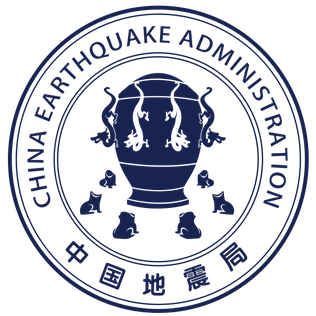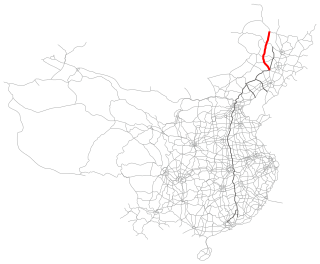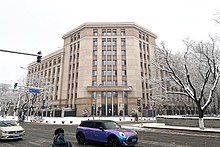
The China National Space Administration is a government agency of the People's Republic of China headquartered in Haidian, Beijing, responsible for civil space administration and international space cooperation. These responsibilities include organizing or leading foreign exchanges and cooperation in the aerospace field. The CNSA is an administrative agency under the Ministry of Industry and Information Technology.

The University of International Relations is a public university in Haidian, Beijing, China.

The Ministry of Education of the People's Republic of China is a constituent department of the State Council, responsible for basic education, vocational education, higher education, and other educational affairs throughout the country. The Ministry of Education acts as the predominant funder of national universities and colleges in China. The ministry also accredits tertiary institutions, degree curriculum, and school teachers of the country.

National Administration of Traditional Chinese Medicine is a state administration of the People's Republic of China under the jurisdiction of the National Health Commission, responsible for the regulation of traditional Chinese medicine industry.

The China Earthquake Administration is a public institution managed by the State Council at the deputy ministerial level in charge of national earthquake disaster reduction work. It is currently managed by the Ministry of Emergency Management.
The constituent departments of the State Council are the principal units of State Council of the People's Republic of China. Types of departments include ministries, commissions, the People's Bank of China and the National Audit Office.

The Li Keqiang Government was the Central People's Government of China from 15 March 2013, when Premier Li Keqiang took office, until March 2023. It succeeded the Wen Jiabao government. Premier Li is ranked only second to Party general secretary Xi Jinping among 7 members of the 18th and 19th Politburo Standing Committee, top decision-making body of the Chinese Communist Party (CCP).

Xiong'an New Area is a state-level new area in the Baoding area of Hebei, China. Established in April 2017, the area is located about 100 kilometres (62 mi) southwest of Beijing and 50 kilometres (31 mi) east of downtown Baoding. Its main function is to serve as a development hub for the Beijing-Tianjin-Hebei (Jing-Jin-Ji) economic triangle. Additionally, "non-core" functions of the Chinese capital are expected to migrate here, including offices of some state-owned enterprises, government agencies, and research and development facilities. The city is planned to be erected by 2035, and to be completed by the middle of the 21st century.
The Shanghai–Chongqing–Chengdu high-speed railway is a high-speed rail line under construction in China. The Chinese name of the railway line, Huyurong, is a combination of the abbreviations for Shanghai, Chongqing, and Chengdu. It will run in an east-west direction largely parallel to the Yangtze River, connecting the cities of Shanghai, Nanjing, Hefei, Wuhan, Chongqing and Chengdu.

The World First-Class Universities and First-Class Academic Disciplines Construction (世界一流大学和一流学科建设), together known as Double First-Class Construction (双一流建设), is a higher education development and sponsorship scheme of the Chinese central government, initiated in 2015. There are 147 universities and colleges selected to be part of the program.

The Ministry of Culture and Tourism of the People's Republic of China (中华人民共和国文化和旅游部) is a constitute department of the State Council of the People's Republic of China in charge of culture and tourism.

The Tsunami Advisory Center of the Ministry of National Resources is a Chinese administrative agency that aims to mitigate tsunami damage in the coastal areas of China. The agency is also known as the UNESCO Intergovernmental Oceanic Committee South China Sea Regional Tsunami Warning Center, which is abbreviated as the South China Sea Tsunami Advisory Center (SCSTAC). It was founded in 2013 and is a subsidiary of the Ministry of Natural Resources of the People's Republic of China and the National Marine Environmental Forecasting Center.

The Chinese Academy of Agricultural Sciences is the Chinese national, agricultural scientific research organization.

National Fire and Rescue Administration (国家消防救援局) is the state emergency service force for firefighting and rescue in China, which is part of the civil service and is administered by the Ministry of Emergency Management (MEM).
Territorial spatial planning is the spatial planning system of the People's Republic of China which, according to its official definition, serves as the guide of the country's territory's development, the blueprint of sustainable development, as well as the fundamental basis of all kinds of development. Territorial spatial planning is an "all-in-one" planning encompassing former major function zone planning, land-use planning, urban and rural planning, as well as other different types of spatial planning.

Zhijiang Xinyu is a book written by Xi Jinping, then the party secretary of Zhejiang Province using the pen name "Zhexin". It was initially a personal column about political ideas published on the front page of Zhejiang Daily from 25 February 2003, to 25 March 2007. Xi published 232 essays in this column. In August 2007, these essays were published in a book also titled Zhijiang Xinyu in chronological order. The name of this book's English edition first published in 2019 is Zhejiang, China: A New Version for Development.
Peace Science Research Center is a peace studies organization under School of History, Nanjing University. The organization is an extension center which was dedicated to cause attention of peace issue in Nanjing City and promoted the peace education, researches and organized events. The most significant accomplishment is the application of international peaceful city for Nanjing in 2017 and certified by World Peace Association. It is also the first city in China to join the organization.

The Shuangliao–Nenjiang Expressway, designated as G4512 and commonly referred to as the Shuangnen Expressway, is a partially completed expressway in China. It is a major north–south expressway that when complete, will connect the cities of Nenjiang City, in Heilongjiang, with Shuangliao, in Jilin, near the border with Inner Mongolia.

"One institution with two names" is a bureaucratic arrangement in the Chinese government wherein a government agency exists in name only, and its functions are in practice performed by another agency or a Chinese Communist Party (CCP) organization, so that in effect one institution has two or more governmental brands or trade names to use selectively for political, historical, or bureaucratic reasons. This type of arrangement was historically common until the mid–1980s, but has been extensively revived by reforms which began in 2017.
China uses various methods to carry out nationwide anti-drug publicity and education and popularize drug prevention knowledge. The main purpose is to strengthen citizens' anti-drug awareness and improve citizens' awareness of the harm of drugs. A major task of comprehensive anti-drug publicity and education is to popularize drug prevention knowledge, reveal the serious harm of drug abuse to individuals, families, and society, strengthen the anti-drug awareness of the entire population, especially young people, educate the public security bureau to combat drug-related crimes, and build an effective mechanism for the whole society to prevent drug abuse. Minimize the proportion of new drug addicts. It can be said that the anti-drug publicity and education work with preventive education as the main task is the fundamental solution to the anti-drug work, and its effect kills two birds with one stone.


















